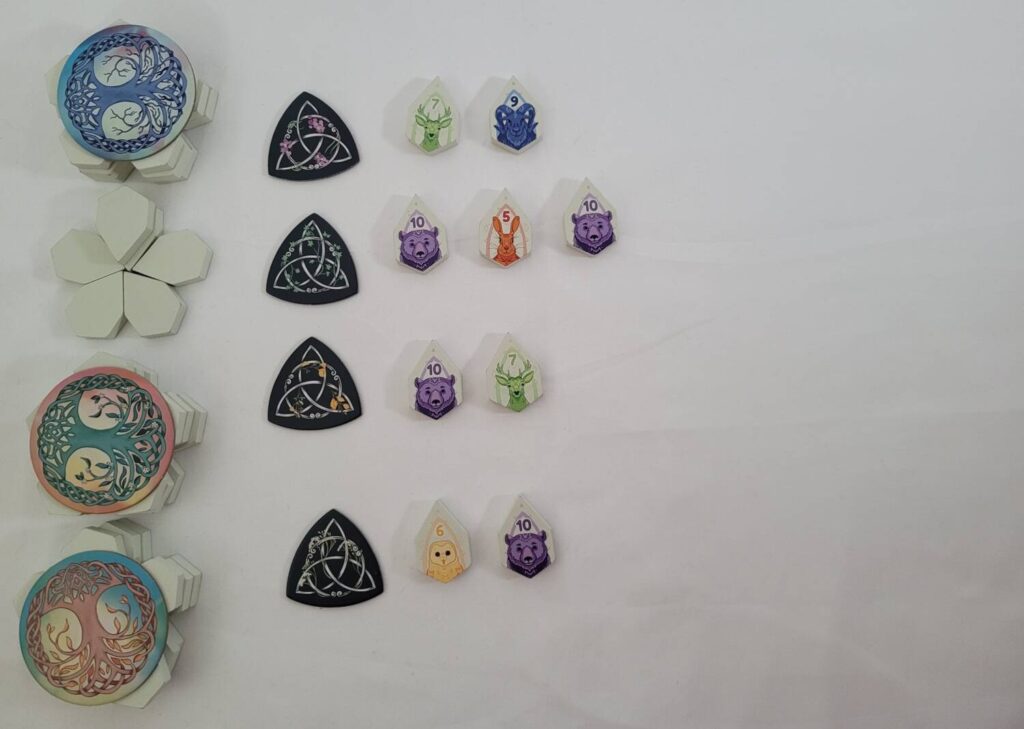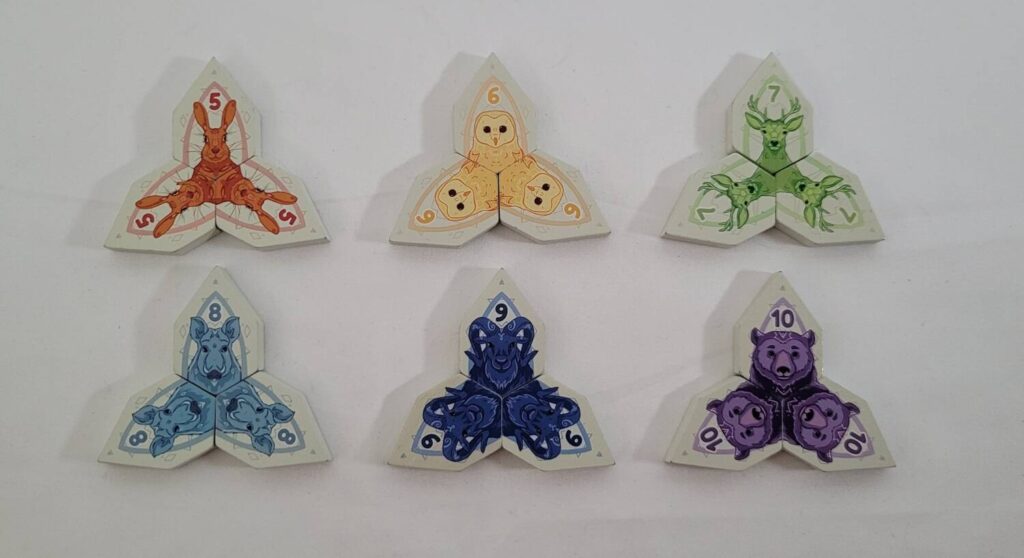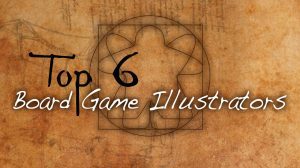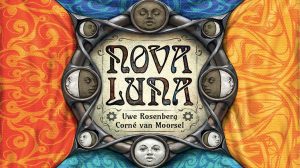Disclosure: Meeple Mountain received a free copy of this product in exchange for an honest, unbiased review. This review is not intended to be an endorsement.
The triquetra is a triangular figure composed of three interlaced arcs. It’s a symbol that’s been used for thousands of years primarily as a decorative element, but sometimes in a more symbolic fashion, its triple knots infused with some sort of meaning or purpose. Its origins are unknown, but its usage began to become popular around the 4th century B.C.*
In the game of Triqueta, players will be competing against their opponents to create, and draft, rows of differently illustrated animal tokens in an effort to end the game with no more than exactly three of each. As the prefix tri- in the title implies, in the game of Triqueta, three is the magic number. If you end the game with fewer than three of a specific type of animal token, you’ll earn a few points, but not as many as you’d earn if you had three. And, going over three results in a penalty. At the end of the fourth round, the player who has earned the most points wins.
Of course, this is an oversimplification. If you’d like to learn a bit more about the specifics of the gameplay, read on. Otherwise, feel free to skip ahead to the Thoughts section.
* The rule book acknowledges that the terms triqueta and triquetra are interchangeable.
Of Towers, Tokens, and Triquetas
During setup, all the Animal tokens (of which there are six types with each type having a different score value) are randomly drawn from a cloth bag and placed face down into four different three-layered stacks (5 tokens per layer) called ‘towers’. The three Tree tokens are placed on top of three of the towers. The uncovered one is the active tower for the first round. There are also a number of Round markers (one per player) that are placed into the center of the table.

On a player’s turn, they have one of two options: draw an Animal token from the active tower or take an Animal row. If a player opts to draw, they look at the token they’ve drawn in secret. Then they may either place the Animal token to the right of one of the Round markers, either adding to or creating a brand new row of Animal tokens, or they may opt to keep the drawn token face down in front of them. This second draw option can only be used twice per game.
If a player opts to take an Animal row instead, they collect both the Round marker and the Animal tokens. The Round marker is used to remind the player that they have already grabbed a row this round and are out of the running for the remainder of the round. The Animal tokens they received are arranged in matching groups of three (a.k.a. – triquetas). Any collected Animal tokens of that type in excess of three are placed on top of this and will be worth negative points during scoring.

The round ends once the final row of Animal tokens has been collected. Any tokens remaining in the current round’s tower are discarded. The last player to collect an Animal token becomes the start player for the next round and receives the start player token. They will take the Tree token off of the top of one of the remaining towers. That tower becomes the active tower for the next round.
Of Triumph
The game ends at the end of the fourth round. At this time, anyone holding any facedown Animal tokens have the option to add any of them to their collected Animal tokens or discard them, if they wish. Then, final scores are tallied.
Any partial triquetas (one or two Animal tokens) are worth the number of Animal tokens. Any exact triquetas are worth the number of points printed on the tiles. Any collected groups of Animal tokens in excess of three are worth a negative point per tile in excess of three. Lastly, the player holding the start player token earns an extra point, and players earn one point for each Tree token they have collected.

The player with the most points is the winner.
Thoughts
When I first cracked open the box for Triqueta, I was immediately impressed by the quality of the craftsmanship. The screen-printed wooden pieces are nice and sturdy. I think they might even be lacquered as there’s a nice shine to them. The cardboard bits—what few of them there are—are of a decent thickness. Even the drawstring cloth bag is worthy of note, if not for its quality, then for just being present. There are so many games out there that really need a cloth bag or two, but just don’t have them.
When it comes to visual presentation, Annika Heller (the artist for 5 Towers) knocks it out of the park. Her illustrations (what few of them there are) lend the game a nice table presence. That being said, I’m not certain that the game really needs any artwork.

There’s no rhyme or reason to the theme. Why am I collecting animals? Where did the animals come from? Is the game taking place in a zoo? A jungle? Who knows. It’s never explained.
At its heart, Triqueta is a pure abstract. The Animal tokens could just as easily have been tokens with numbers on them for all that the animals have to do with anything. I mean, heck, there’s not even a bonus for having collected an entire set of different Animal tokens, much less an entire set of different triquetas.
And while I’m harping on all things Triqueta-related, I’d also like to take a moment to talk about how obnoxious the setup is. Hands down, setting up the game is the absolute worst part of the game. Each of the Animal tokens is vaguely guitar pick shaped. During setup, you’ve got to stack these pieces one atop the other. That wouldn’t be so bad if there were only a small handful of them, but there are sixty of them, and they’re tiny, and you’ve got to arrange them just-so, and they need to remain stacked so that you can place the Tree tokens on top of them, and you’ve got to create four towers of them. You can probably sense my frustration.
Setting up this game is no fun.
That being said, once you’ve got it all set up and ready to go, Triqueta is actually a pretty solid game. Even though Triqueta may seem placid on the surface, it’s anything but. The rules are simple: add a tile to a row, or claim a row. It isn’t until you’re faced with this decision that you realize just how deceptive this simplicity actually is.
Consider the question of which row you should add a tile to. How close are your opponents to completing their triquetas? Will adding the tile you’re holding to a row allow them to claim it and complete one or more triquetas? Is that something you want to happen or avoid? Is there a row you’ve got your eye on? Maybe you should add the tile to a row you’re less concerned about to make it juicier for your opponents so they’ll leave the row that you really want alone. Or, maybe you add it to a row that already has one or more tiles that match the one you’re holding to force someone to go over three of the tile should they claim the row.
Then there’s actually claiming a row. If you see a row that could help you, do you claim it right away? Or, do you hold out and let it build up a bit so that it’s even better for you? If you hold out, though, there’s a chance one of your opponents will add something to it that will cause you to blow one of your triquetas. So, hold off, or act now?
If you’re too greedy, you’ll shoot yourself in the foot. If you’re too lax, you’ll shoot yourself in the foot. The back of the box reads: “Can you time it right and control your greed enough to outscore the others?” And that about sums it up.
It’s an interesting game, and a fun one at that.











